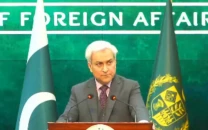Government urged to follow Australia in selling cigarettes in plain packages
NGO believes the step will help curb consumption of cigarettes.

Cigarettes and other tobacco products in Pakistan should be sold in plain packages, TheNetwork for Consumer Protection said in a statement on Thursday.
The statement read that a ruling in Australia’s highest court requiring tobacco products to be sold in plain packages sets “an example for Pakistan to follow”.
Australia’s plain packaging law, which was enacted last year and challenged in court by four tobacco companies, will save lives and stop tobacco companies from using their packs to make cigarettes appealing to kids, said the statement.
Pakistan’s government should follow suit, said the statement, as the country has the highest number of youth and poor people using tobacco products.
The organisation said that using plain packaging will make the pictorial warnings more effective. Removing colours from cigarette packs and misleading terms such as “smooth”, “gold” and “silver” would reduce false beliefs about the harmfulness of cigarettes.
“Adults and adolescents perceive cigarettes in plain packs to be less appealing, less palatable, less satisfying and of lower quality compared to cigarettes in current packaging,” TheNetwork said in its statement.
Cigarette packs sold in the country are currently required to have 40% of the area covered with a pictorial warning, which is much less than the TheNetwork’s recommended coverage area of at least 75% on the front of the pack.
As Pakistan’s tobacco control laws restrict mass media advertisement, the tobacco industries turn to shops, decorating them with promotional material. “The point of sale (POS) advertisement can be controlled by effectively enforcing the existing laws,” said TheNetwork Executive Coordinator Nadeem Iqbal.
The non-government organisation (NGO) monitors POS advertisement of tobacco industry in 10 major districts of Pakistan. Its initial findings revealed that 78% shops have tobacco advertising. Moreover, the NGO found 87% of the shops to have been illegally selling tobacco to children.
Pakistan is obliged under the Framework Convention on Tobacco Control to prohibit all forms of tobacco advertising, promotion and sponsorship that promote a tobacco product, said the statement.
Published in The Express Tribune, August 17th, 2012.



















COMMENTS
Comments are moderated and generally will be posted if they are on-topic and not abusive.
For more information, please see our Comments FAQ